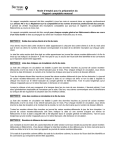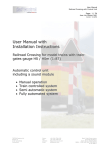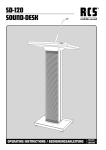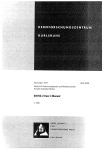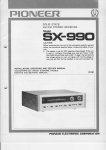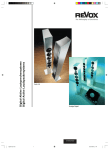Download Manual - Klangwerk
Transcript
K L A N G W E R K ® ELLA ACTIVE SPEAKER-SYSTEM MANUAL KLANGWERK GmbH Wieslergasse 6 8049 Zürich - Switzerland Fon +41 (0)43 818 44 90 Fax +41 (0)43 818 44 91 [email protected] www.klangwerk.ch Content Connections Aufstellung 1 Placement 2 - Preamplifier - Stereofonie - Signal Cable - Balance - Current Cable - Symmetrie - On-/Off - Stability - Stereo - Balance - Acoustical Symmetry - On Wall - Free Space - Listening Angle - Speaker Axis 3 - Direct Sound - First Reflections - Placement Examples 4 Electronics 5 - 2-way Active System - Overload Protection - Level - Roll-Off - Electronics Scheme Listening to Music 6 - Phase Linearity - Spaciousness - Level - Impulse Behaviour Safety Instructions / Handling Tecnical Data 7 Care Instructions Warranty 8 Protocol 9 Please read this Manual before unpacking and installing the speakers, especially the chapters Connections and Safety Instructions. Speakers should be unpacked, installed and moved always by 2 persons. Place the speakers with the back (grey side) on a soft surface. Then you can fix the the base plate with the screws which are packed by. First screw all of them loose and then screw them tight. Then turn the speakers in the vertical position by placing them on the rear edge of the base plate. When you move the speakers in another position, always place them carefully first on the rear edge of the base plate. The other edges could be too weak. © by KLANGWERK GmbH, Zürich, Switzerland 1 Connections ELLA is an active loudspeaker-system. The main amplifier is integrated in the loudspeaker and has been adapted for it. Therefore the loudspeakers have connections for mains power and the signal. The signal cable has to be connected to the output of the preamplifier or the integrated amplifier. Sometimes also CD-Players have variable preamplifier-outputs. Please refer to the manual of the device. Source Preamplifier PPP rrr eee aaa mmm ppp llliiifff iiieee rrr///BBB aaa lllaaa nnn ccc eee ddd TTT eee ccc hhh nnn ooo lllooo ggg yyy For the best sound, the preamplifier should have a balanced layout or at least balanced outputs (XLR-Plugs). It should also have a sufficient Voltage Output (max. 24V Peak to Peak) to get the maximum sound pressure level. The balanced technology has several advantages: The signal cable can be as long as needed for optimum placement of the loudspeakers without losses. The Conductors (+ and -) are seperated and shielded. Balanced technology means that the + and the - Signal are amplified separately. In the receiving device (the main amplifier) only the difference between the signals is amplified and therefore any disturbances are filtered out. This operation doubles also the amplitude of the signal which doubles the slew rate of the signal. The sound is more dynamic and clear. If the preamplifier has no balanced output you can use an interface plug or a XLR-Cinch signal cable . Sometimes also the output voltage of the preamplifier can be increased. Please refer to the manufacturer/distributor of the preamplifier. SSS iiiggg nnn aaa lllCCC aaa bbb llleee ///CCC uuu rrr rrr eee nnn tttCCC aaa bbb llleee We recommend using our signal and current cables. They have angled plugs what allows the loudspeakers to be positioned close to a wall. Our signal cable has a special construction with 4 conductors which are connected crosswise for an additional protection against disturbances. We deliver the cable to order in any length you require. OOO nnn --/// OOO fff fff When all connections have been made, the devices can be switched on. Please switch on first the preamplifier and then the loudspeakers. The loudspeakers must not be switched off after use because the power consumption is low. For additional comfort and to save energy, all devices should be connected on a switchable power strip. It is preferable to use power strips which are protected against lightning strikes. © by KLANGWERK GmbH, Zürich, Switzerland 2 Placement The placement of the speakers is very important for a high sound quality at home. The following chapters help you to improve the placement. We offer you also a special service: When you mail or fax us a plan (in scale) and photos of your listening room, we will draw our proposals for the loudspeaker placements and sometimes also suggestions for a rearrangement of your room. SSS ttt aaa bbb iiillliiittt yyy The loudspeakers must be in a vertical position and placed on a solid, flat ground. They should stand firmly and not rock. If the ground is not flat enough and not horizontal, you should place a firm material under the base plate. SSS ttt eee rrr eee ooo This 50-year old standard for reproducing music can establish a three dimensional soundstage and a realistic sense for the spaciousness of the original room. Stereophonic reproductions deceive the ear-brain system to get this impression. The human ear can detect the direction and the distance of a sound source because the sound arrives with a different intensity, delay and frequency response on the left and the right ear. When all of these parameters are simulated with two speakers, the brain gets the impression of hearing a phantom sound source at the direction of the original source. When the loudspeakers produce irregularities through poor matching of the left and right loudspeakers, bad placement in the room or other problems, the impression of the original space will not be clear. Acoustic shading of the ears = difference in frequency response = difference in sound pressure level = difference in sound delay sound source A B ere diff nce oun in s phantom sound source dd el a y BBB aaa lllaaa nnn ccc eee The loudspeakers must have an equal distance to the listening position. A Mono signal, for example a speaker on the radio must appear to be exactly in the middle between the loudspeakers. AAA ccc ooo uuu sss ttt iiiccc SSS yyy mmm mmm eee ttt rrr yyy The acoustic environment of both loudspeakers should be similar. You can here how different the loudspeakers sound in their environment if you listen again to a Mono signal with only the left and then only the right speaker. You can improve the acoustic environment in many ways to get the best results. You can ask a professional acoustician to get ideas for improvements. With ELLA you can use the Roll-Off selector to get a closer matching between both loudspeakers in the lower frequency range. © by KLANGWERK GmbH, Zürich, Switzerland Placement 3 OOO nnn WWW aaa llllll---FFF rrr eee eee SSS ppp aaa ccc eee 50cm ELLA can be placed on a wall and also in free space. In both positions the sound is of high quality due to the special form and the Roll Off function in the amplifier. With our angled plugs, a minimum distance of 3cm for the cooling of the amplifier is guaranteed. If one loudspeaker can't be placed directly on a wall it is better to place it more than 50cm away from the wall. The distance to the next corner of a room should not be less than 90cm. 90cm LLL iiisss ttt eee nnn iiinnn ggg aaa nnn ggg llleee A listening angle of 60° for stereo recordings is common. This is the non-official standard in recording studios. However we recommend to evaluate placing the loudspeakers at wider angles. With wider angles the acoustic shadow of the head is better utilised. The separation between the left and the right channel will be better. The sound will have more plasticity. Angles up to 100° are possible because ELLA has a high linearity in phase. Some recordings may have an unnatural wide sound stage, but in most cases the sound impression will be more realistic and the sound space more sculptural. The disadvantage of wider angles is that the listening zone can be reduced. 100° 60° 60° LLL ooo uuu ddd sss ppp eee aaa kkk eee rrrAAA xxx iiisss The loudspeaker axis should not be orientated directly to the listening position, but should cross in front of it. An angle of 10-20° from the axis is recommended. The loudspeakers have been optimized for this orientation. The soundstage will be deeper and more precise. Another advantage is the extension of the listening zone, because of an acoustic behaviour of most loudspeakers and especially ONDA: The sound pressure off axis will be reduced in the medium and even more in the high frequency range. Listening positions off centre will be nearer to one of the loudspeakers but also more off axis with regards to the nearer loudspeaker. The sound pressure of the left and the right loudspeaker will therefore be equal in a wider zone, which is important for keeping a good stereo effect. The orientation of the loudspeaker axis can also be used as a high frequency selector: on axis the level is the highest. reduction of sound pressure (medium-high frequency) © by KLANGWERK GmbH, Zürich, Switzerland reduction of sound pressure (medium-high frequency) Placement 4 DDD iiirrr eee ccc tttSSS ooo uuu nnn ddd ---FFF iiirrr sss tttRRR eee fff llleee ccc ttt iiiooo nnn sss The ear can differenciate between the direct sound and the reflexions when the time delay is sufficient. With a small delay the reflections appear to be added to the direct sound. This ability of the ear is crucial for spacial listening. The loudspeakers should be positioned in a way to maximise the delay between the direct sound and the first reflections. This means, the difference in distance between the direct and the reflected sound path must be as high as possible. The more reverberant the room acoustic is, the more important this rule becomes. Short reflections can be damped with special acoustic damping material. The direction of the first reflections has also a certain effect. In the first example some reflections come from the front wall. The sound stage will seem deeper. In the second example more reflections come from the sidewall. The sound stage will seem wider. It is recommended to play with such effects to optimize the subjective sound impression. EEE xxx aaa mmm ppp llleee sss The following schemes show the variety of possible placements for the loudspeakers. Not all positions give the same sound quality. Each room must be considered separately. Our room acoustic services can advice you in special cases and for demanding projects create a complete design. © by KLANGWERK GmbH, Zürich, Switzerland Electronic 5 222 ---www aaa yyy AAA ccc ttt iiivvv eee MMM ooo ddd uuu llleee ELLA is powered by an integrated 2-way active amplifier module. Both sections, the treble- and the midrange/low frequency range are driven by their own power amplifier which are optimised for each section. The movement of the membrane is controlled by an adaptive output impedance system (AOI). A phase compensation in the crossover region matches perfectly the treble and the mid-/low frequency range. The treble frequency range can be adapted to match the left and the right loudspeaker. OOO vvv eee rrr lllooo aaa ddd PPP rrr ooo ttt eee ccc ttt iiiooo nnn The loudspeakers are protected against overload. The regulation is dynamic. When the protection circuit detects an overload, the sound pressure over the whole frequency range will be reduced until the loudspeakers are protected from damage. The frequency response will be even, also when the signal is too loud. As usually the bass section suffers most from overload, the maximum sound pressure level can be raised by turning down the Roll Off control. The electronics itself is also protected from overload. Please always replace the fuse with the same type as marked on the amplifier module. LLL eee vvv eee lll The power output of the amplifier can be reduced with the level-button to adapt it to the level of the preamplifier. Usually the level must not be reduced and remain in the position CAL (calibrated). When the loudspeakers can not be placed in the same distance to the listening position, the level of the nearer loudspeaker can be reduced to get the same sound level for both loudspeakers. A mono signal (for example a news speaker on the radio) must be appear to be exactly between the loudspeakers. RRR ooo llllllOOO fff fff If a loudspeaker is positioned near a wall, the level of the low frequency will rise unnaturally. With the Roll-Off button the level can be reduced below 400 Hz to equalize this effect. Usually the level must be lowered between 4.5 to 6dB to get a smooth response over the whole frequency range. The precise level can be determined by ear, with a Test-CD or a special measuring equipment. The left and the right loudspeaker must be adjusted separately. The level determined should be noted in the protocol. The Roll-Off control can also be used to combine ELLA with a Subwoofer. A subwoofer is useful when high sound pressure levels in the low frequency range down to 20Hz are requested. Please use only high-quality Subwoofers with flat low pass filters (-6dB to -12dB/Octave). To get best results, the frequency and phase response of both systems must be measured and adapted by a professional. Usually put the Roll-Off control for ELLA between -6dB to -10dB and adapt the output of the subwoofer. SSS ccc hhh eee mmm eee AAA mmm ppp llliiifff iiieee rrrMMM ooo ddd uuu llleee LP HP LP AOI* POWER AMP CPR* HP 1=GND 2= (+) 3= (-) INPUT ROLL OFF LIMITER LEVEL 115V/230V EMI LP ON/OFF FUSE +/-45V TRAFO CPR* = Compensated Phase Response System AOI* = Adaptive Output Impedance System © by KLANGWERK GmbH, Zürich, Switzerland AOI* RECT +/-17V REG POWER TEMP SENS CPR / AOI © by PSI AUDIO, Yverdon, Switzerland POWER AMP Listening to music 6 PPP hhh aaa sss eee llliiinnn eee aaa rrr iiittt yyy The classical dynamic loudspeaker does not have a linear phase response. The initial signal is slightly delayed and this delay depends on the frequency. The passive filters, commonly used to divide the signal to the different loudspeakers in a box, further the delay the signal in the different frequency ranges. A special problem is the crossover frequency between the loudspeakers. The consequence is that a music signal is no longer time coherent when it arrives to the listener. The loudspeaker is no longer phase linear. As music is a sequence of sudden impulses, all these delays produced by the loudspeakers give instruments and voices an artificial character. This effect can specially be heard with dynamic music: fast piano or violin passages, percussive instruments, orchestral music, Jazz etc. The active amplifier technology with Adaptive Output Impedance System (AOI) and Compensated Phase Response (CPR) lead to a time coherent or phase linear reproduction about nearly the whole frequency range. Therefore the sound reproduction is accurate and natural. SSS ooo uuu nnn ddd sss ttt aaa ggg eee ooo fffrrr eee ppp rrr ooo ddd uuu ccc ttt iiiooo nnn sss Time coherent loudspeakers can reproduce the soundstage accurately. Stereo and Surround recordings use time delays to deceive the ear that the original soundstage is present. When a loudspeaker has additional delays, the reproduction of space will be smeared. What has to be considered is that phase distortions can simulate an additional spaciousness, not contained on the recording. With phase linear speakers this pseudo space will be absent and sometimes "missed" and the recording seems "drier". III mmm ppp uuu lllsss eee bbb eee hhh aaa vvv iiiooo uuu rrr The usual dynamic loudspeaker works as a mass-spring system: an electrical input will drive the stiff membrane from the zero point in one direction and back in the other direction. The membrane (the mass) tends to oscillate over the predicted point because it is held back by the mechanical (spring) of the loudspeaker. The exact impulse will not be produced immediately. Music is based on continuously changing oscillations why a dynamic loudspeaker has a poor impulse behaviour. An important benefit of the active amplifier with AOI and CPR is the dramatic improvement of the impulse behaviour of the dynamic loudspeakers, because its movement is directly controlled by the amplifier. With passive systems this control is nearly absent. What you will hear is that the sound is very precise and natural and you can listen to the music for hours without fatigue. LLL eee vvv eee lll In most appartments it is not possible to listen to the music at high volumes. Small rooms tend to compress the sound to an unnatural effect. To get a realistic effect and for everyday-use it is important that a loudspeaker sounds convincing at moderate levels. You will realize when listening with ELLA, that high sound pressure levels are not important to get the full range of details in the music. This is another benefit of the active technology. © by KLANGWERK GmbH, Zürich, Switzerland Safety instructions / Handling All of the used components within this device fulfill the actual European standards for safety and handling. Please place the loudspeakers on a rigid horizontal ground. Install the speakers that they are stably positioned. Do not expose the loudspeakers to strong sunlight. Don't place the speakers nearer than 40cm in front of a window. The room climate should be dry. When transporting the loudspeakers, wrap them in our packing material. Cover the membranes with the stable cardboard which was packed with the loudspeakers. Always move the loudspeakers with two people. When you place them on the floor, please put them carefully on the back edge of the base plate and set them upright afterwards. Never put them on the corners of the base plate as the corners are not strong enough. Do not move the loudspeakers on the floor. Otherwise the floor could be damaged. Please prevent small children to touch the loudspeakers, especially the membranes. The amplifier must be free to get sufficient air for cooling. A minimum distance from 3cm to a wall is enough. The angled plug gives the minimum distance. Prevent any liquid getting inside the amplifier module. When cleaning the box always unplug the mains cable first. The device can only be opened by a specialized person. If the loudspeaker seems to be damaged unplug it from the mains and call your local specialist. The fuses can be changed from outside. Always unplug the loudspeaker from the mains when you change the fuses. Use the same tipe of fuse when exchanging the fuses. A second fuse is packed in the small fuse holder. When a thunderstorm is announced, the loudspeakers should be unplugged from the mains to prevent a shock through lightning. A special mains power strip can reduce the risk of damage. The membranes of the speakers are very sensitive and can easily be damaged. They should be touched very carefully for cleaning (see care instructions). Technical data Full Active 2-Way Loudspeakersystem Tweeter: Woofer-Midrange: 25mmØ / Titan-Membrane, Waveguide, Acoustic Lens 3x 145mmØ / HDA-Membrane (High-Definition-Aerogel) Active Electronics with Adaptive Output Impedance System Sensitivity for 90dB SPL @1m: Input Impedance: Input Overload: Signal to Noise Ratio: Power RMS: Continuous Max. SPL@1m: Frequency Response (-6dB): Crossover Frequency: Roll Off below 400Hz: 245mV (adjustable) balanced, 5kOhms 20Vpp -96dBA 40+30W 103dB 39Hz-22’000Hz 1500Hz 0dB - 3dB/Oktave Signal Input: Voltage: Power Consumption: XLR F/3P 115/230V (50-60Hz) 7-70VA Box Material: Baffle Material: MDF Nextel anthracite CREANIT®, white, light grey Net Weight: Dimensions: HxWxD 19kg 1045x210x168mm Technical adaptions are subject to change without notice © by KLANGWERK GmbH, Zürich, Switzerland 7 Care instructions Before cleaning the speakers must be unplugged from the mains supply. The cabinet can be cleaned with a dry soft towel. Strong dirt can be removed with special alcohol for cleaning. The white Creanit-surface (but NOT the black Creanit base-plate) can also be cleaned with the special white 3M-scotchbrite towel which is packed with the loudspeakers. Small scratches on the Nextel lacquered grey surface can be covered with the lacquer in the small bottle which is also packed with the loudspeakers. Use a very small amount of the lacquer to cover the spot. It is preferable to repeat the operation several times. Scratches in the white Creanit surface can be polished with the 3M-Scotchbrite towel. For very large scratches a very fine emery paper can be used. Please refer to a specialist for this operation. The black Creanit base plate can only be refurbished by a specialist. The membranes should be cleaned from time to time with the fine brush which is packed with the loudspeakers. Be very careful about the cupper conductors of the MANGER-Transducer and don't touch them where they penetrate the membrane. Warranty The warranty is lasting 3 years and is only available for the first owner. It starts on the date of purchase of the loudspeaker. The invoice is the warranty-card and must be stored. During the warranty-period all defects which can proved to be due to manufacturing defects will be covered. This will be done through replacement or an improvement of delivered parts and has to be done through elements of our choice and through approved persons. It can not be done through other third persons. Other pretensions, especially compensations for following damages are excluded. No other manipulations than described in the manual are tolerated. In case of a warranty cause, please refer with the invoice to the local dealer or directly to us. If the loudspeaker must be sent to us, proceed as follows: Write a description of the defect. Order a shipping box and material and send the product to us. The transport costs and the risk must be covered by the purchaser. Not covered by the warranty are: - Damages from transport (visible or unvisible) Please refer to the transportation company. - Scratches on the cabinet. These must be declared and documented 5 days of purchasing. - Defects which are consequence of incorrect or non careful handling, violence, force majeure. - Devices which have been repaired or changed through other than our approved persons and without our authorisation. - Following damages on other devices - Compensations in money when repaired through third persons without our authorisation - Devices where the serial number has been changed or is no more visible. - Changes in behaviour through natural aging or using of the device © by KLANGWERK GmbH, Zürich, Switzerland 8 Protocol 9 Serial Number: Controlling Person: Date: Modification: Responsible Person: Date: Level (dB) L/R: Speaker/ Position Date Roll Off (dB) L/R Listening Room/ Position: Date Remarks: © by KLANGWERK GmbH, Zürich, Switzerland











